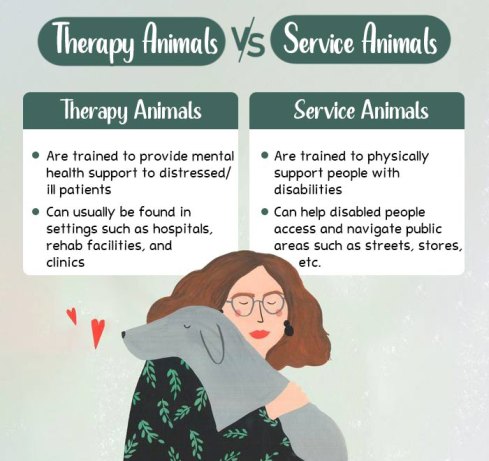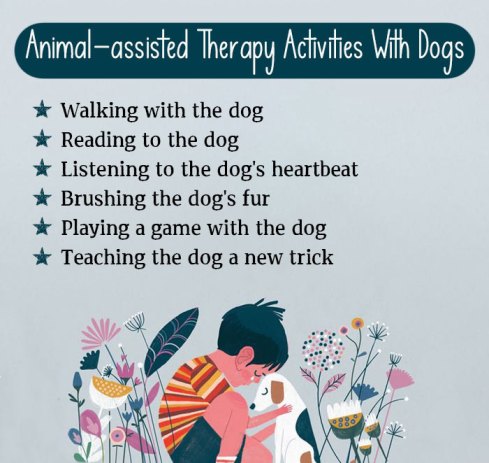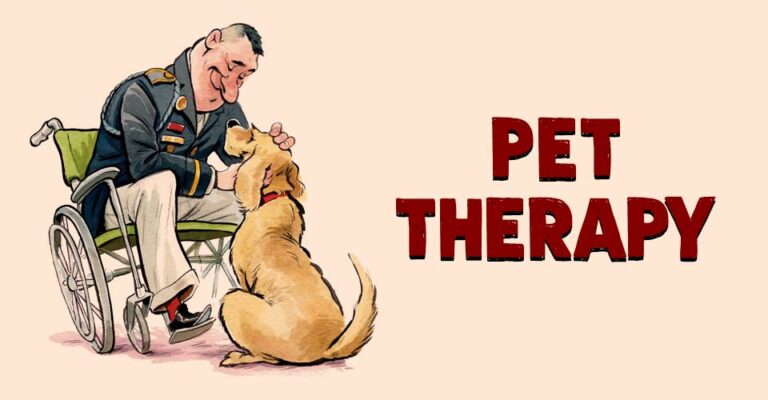Pet therapy refers to the use of animals as aides in the treatment of mental and physical disorders. It usually involves a guided interaction between a patient and a trained “therapy animal”.
What Is Pet Therapy?
Pet therapy or animal-assisted therapy (AAT) 1 Hajar R. (2015). Animal-Assisted Therapy. Heart views : the official journal of the Gulf Heart Association, 16(2), 70–71. https://doi.org/10.4103/1995-705x.159228 involves formal, structured, and goal-oriented interactions between animals and patients—helping the latter achieve certain treatment outcomes.
In most cases, pet therapy for the elderly, children, military veterans, and the mentally ill is used as an alternative or complementary type of therapy to treat depressive symptoms, anxiety, untreated trauma, developmental disorders, etc.
History
The term “pet therapy” was coined in 1964 by child psychologist Boris Levinson 2 Fine, A. H., Beck, A. M., & Ng, Z. (2019). The State of Animal-Assisted Interventions: Addressing the Contemporary Issues that will Shape the Future. International journal of environmental research and public health, 16(20), 3997. https://doi.org/10.3390/ijerph16203997 . However, as far back as 1792, the medical importance of pet therapy was first documented when British philanthropist and quaker William Tuke incorporated birds and animals in the treatment plan for people with mental health needs in his asylum, The York Retreat.
In the 1970s, Samuel Corson and Elizabeth O’Leary Corson 3 Hooker, S. D., Freeman, L. H., & Stewart, P. (2002). Pet therapy research: a historical review. Holistic nursing practice, 16(5), 17–23. https://doi.org/10.1097/00004650-200210000-00006 , psychologists at Ohio State University, conducted the first empirical studies of canine-assisted therapy. They laid the groundwork for modern animal-assisted interventions.
Animal-Assisted Activities vs Pet Therapy
The broad category of animal-assisted interventions includes animal-assisted therapy (AAT), animal-assisted education (AAE), and animal-assisted activities (AAA). However, in most cases, people mistake animal-assisted activities (AAA) for animal-assisted therapy (AAT) or pet therapy.
Both types are unconventional therapy types 4 Boldig, C. M., & Butala, N. (2021). Pet Therapy as a Nonpharmacological Treatment Option for Neurological Disorders: A Review of the Literature. Cureus, 13(7), e16167. https://doi.org/10.7759/cureus.16167 that include animals’ use in treatment and recovery. However, the two are not the same. Pet therapy or animal-assisted therapy (AAT) involves including animals as aides in psychotherapy.
AAT comprises a formal, structured set of therapeutic sessions that helps people reach specific goals in their physical or mental health treatment. AAA, on the other hand, involves more casual meetings in which an animal and its handler interact with one or more people for recreation or comfort.

How Does Pet Therapy Work?
The therapeutic uses of pet therapy are well-researched. Interacting with animals has been proven to help people suffering from physical and/or mental health disorders cope and recover better.
Playing or stroking animals, or even watching them can lower the levels of cortisol and increase the production of serotonin, making us less stressed and happier. Pet therapy for depression treatment and addressing trauma, social anxiety and isolation, and chronic self-harm are in practice.
Read More About Treatment For Depression Here
Types Of Pet Therapies
The primary 5 Boldig, C. M., & Butala, N. (2021). Pet Therapy as a Nonpharmacological Treatment Option for Neurological Disorders: A Review of the Literature. Cureus, 13(7), e16167. https://doi.org/10.7759/cureus.16167 types of pet therapy include:
1. Therapeutic Visitation
In this type of pet therapy, household pet owners take their pets to visit healthcare facilities on a voluntary basis. The animals often help hospitalized patients feel happier and more hopeful, pushing them toward faster recovery.
2. Animal-assisted Therapy
In this therapy, animals are specifically trained 6 Boldig, C. M., & Butala, N. (2021). Pet Therapy as a Nonpharmacological Treatment Option for Neurological Disorders: A Review of the Literature. Cureus, 13(7), e16167. https://doi.org/10.7759/cureus.16167 to assist therapists with their patients. As opposed to therapeutic visitations, in this type of therapy a trained animal-assisted therapist includes a specific animal as part of their weekly therapy sessions.

3. Facility therapy
In this type of pet therapy, therapy animals are trained and made to reside in care centers. They engage with visiting patients who are battling serious mental disorders like PTSD, dementia, etc.
Read More About PTSD Here
Benefits Of Pet Therapy
Studies on human-animal interactions are very few indicating the need for more research in this area. Existing studies showed how a pet can help with mental health and positive physical health effects, but the results have been mixed.
The common 7 Lundqvist, M., Carlsson, P., Sjödahl, R., Theodorsson, E., & Levin, L. Å. (2017). Patient benefit of dog-assisted interventions in health care: a systematic review. BMC complementary and alternative medicine, 17(1), 358. https://doi.org/10.1186/s12906-017-1844-7 pet therapy benefits are:
- Improved patient satisfaction
- Enhanced energy levels
- Greater self-esteem
- Boost in moods
- Decreased loneliness and depressive symptoms
- Increased motor skills
- Improved social skills and verbal communication
- Decreased boredom
- Development of a positive outlook on life
In people with hypertension, particularly the elderly population 8 Cherniack, E. P., & Cherniack, A. R. (2014). The benefit of pets and animal-assisted therapy to the health of older individuals. Current gerontology and geriatrics research, 2014, 623203. https://doi.org/10.1155/2014/623203 , petting animals lower blood pressure, cholesterol levels, and triglyceride levels. This also decreases the risks of cardiac diseases (like stroke and heart failure).
The benefits of pet therapy for seniors also include increased opportunities for exercise as well as socializing and outdoor activities. This, in turn, helps them achieve better cognitive function—thereby reducing their vulnerability to cognitive impairment and memory disorders (such as dementia).
Read More About Dementia Here
Risks Of Pet Therapy
Some of pet therapy’s biggest risks 9 Bert, F., Gualano, M. R., Camussi, E., Pieve, G., Voglino, G., & Siliquini, R. (2016). Animal assisted intervention: A systematic review of benefits and risks. European journal of integrative medicine, 8(5), 695–706. https://doi.org/10.1016/j.eujim.2016.05.005 are with regard to safety and sanitization. People who are allergic to animal dander or have a pathological fear of animals may especially experience negative reactions.
They are at a risk of being exposed to zoonotic pathogens—that too directly in a hospital environment 10 Brodie, S. J., Biley, F. C., & Shewring, M. (2002). An exploration of the potential risks associated with using pet therapy in healthcare settings. Journal of clinical nursing, 11(4), 444–456. https://doi.org/10.1046/j.1365-2702.2002.00628.x —through petting, licking, or contaminated food. The therapy animals can also spread these pathogens from visitors to patients and caregivers or vice versa.
There is also a chance of injuries, such as a fall or bites and scratches. However, in most cases, animals in pet therapy programs are typically screened for behavior and health.
Takeaway
The effectiveness of pet therapy is confirmed by recent research and it is considered a successful non-pharmacological intervention (with little to no side effects) for physical and mental health conditions. It is a viable ancillary therapy especially for people who are fond of animals.
At A Glance
- Pet therapy is a guided interaction between patients and trained “therapy animals”.
- Pet therapy is also known as animal-assisted therapy (AAT).
- It is frequently used as a complementary form of therapy to aid the treatment of or recovery from health conditions.
- It is a non-pharmacological form of treatment method.
- It can be effective in treating trauma, depression, anxiety, neurodevelopmental disorders, etc.
Frequently Asked Questions (FAQs)
1. Is animal-assisted therapy an evidence-based practice?
Animal-assisted therapy is an evidence-based practice drawn from psychophysiological and psychosocial healthcare and human service disciplines.
2. How can a therapy animal give better emotional and social support than a person?
A therapy animal is known to give unconditional love and emotional support to people suffering from poor mental health. They also help reduce feelings of isolation, loneliness, and helplessness.
3. Which disorders can be improved by animal-assisted therapy?
The mental health benefits of pet therapy lie in treating various mental disorders, such as social withdrawal, chronic loneliness, depression, anxiety, PTSD, substance abuse, schizophrenia, developmental disorders, behavioral difficulties, and other physical conditions.
4. Where was animal-assisted therapy first used with individuals with mental illness?
In 1792, British philanthropist and quaker William Tuke incorporated birds and animals in the treatment plan for people with mental health needs in his asylum, The York Retreat. This was the first documented instance of animal-assisted therapy in history.
5. What animal is the most common type used in animal-assisted therapy?
Dogs are the most common animals used in animal-assisted therapy.
6. How is pet therapy administered?
In animal-assisted therapy, a professional therapist includes a trained therapy animal in their sessions. Sometimes, pet owners bring their own pets to healthcare facilities for a ‘therapeutic visitation.’
















Can you provide referrals